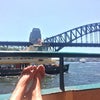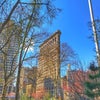The Abbey Church of Saint Peter and Saint Paul, Bath, commonly known as Bath Abbey, is an Anglican parish church and a former Benedictine monastery in Bath, Somerset, England. Founded in the 7th century, reorganised in the 10th century and rebuilt in the 12th and 16th centuries, it is one of the largest examples of Perpendicular Gothic architecture in the West Country.
The church is cruciform in plan, seating approximately 1,200 people. It is used for religious services, secular civic ceremonies and lectures. The abbey is a grade I listed building and is an active place of worship, with hundreds of congregation members and hundreds of thousands of visitors each year.
The building contains monuments to several notable people. It has two organs and a peal of ten bells.
In 675 Osric, King of the Hwicce, granted the Abbess Berta 100 hides near Bath for the establishment of a convent. This religious house later became a monastery under the patronage of the Bishop of Worcester. King Offa of Mercia successfully wrested "that most famous monastery at Bath" from the bishop in 781. William of Malmesbury tells that Offa rebuilt the monastic church, which may have occupied the site of an earlier pagan temple, to such a standard that King Eadwig was impelled to describe it as being "marvellously built", however little is known about architecture of the first building on this site. Monasticism in England had lapsed by that time, but Eadwig's brother Edgar (who was crowned "King of the English" at the Abbey in 973) began its revival on his accession to the throne in 959. He encouraged monks to adopt the Rule of St Benedict, which was introduced at Bath under Abbot Ælfheah (St. Alphege).
Bath was ravaged in the power struggle between the sons of William the Conqueror following his death in 1087. The victor, William Rufus, granted the city to a royal physician, John of Tours, who became Bishop of Wells and Abbot of Bath. Shortly after his consecration John bought Bath Abbey's grounds from the king, as well as the city of Bath itself. Whether John paid Rufus for the town or whether he was given the town as a gift by the king is unclear. The abbey had recently lost its abbot Alfsige, and was according to Domesday Book the owner of large estates in and near the town. It would have been the wealth of the abbey that attracted John to take over the monastery. By acquiring the town of Bath, John also acquired the mint that was in the town. In 1090 he transferred the seat, or administration, of the bishopric to Bath Abbey, probably as an attempt to increase the revenues of his see. Bath was a rich abbey, and Wells had always been a poor diocese. By taking over the abbey, John increased his episcopal revenues. William of Malmesbury portrays the moving of the episcopal seat as motivated by a desire for the lands of the abbey, but it was part of a pattern at the time of moving cathedral seats from small villages to larger towns. When John moved his episcopal seat, he also took over the abbey of Bath as his cathedral chapter, turning his diocese into a bishopric served by monks instead of the canons located at Wells that had previously served the diocese. John rebuilt the monastic church at Bath, which had been damaged during one of Robert de Mowbray's rebellions. Permission was given to move the see of Somerset from Wells – a comparatively small settlement – to the then walled city of Bath. When this was effected in 1090, John became the first Bishop of Bath, and St Peter's was raised to cathedral status. As the roles of bishop and abbot had been combined, the monastery became a priory, run by its prior. With the elevation of the abbey to cathedral status, it was felt that a larger, more up-to-date building was required. John of Tours planned a new cathedral on a grand scale, dedicated to Saint Peter and Saint Paul, but only the ambulatory was complete when he died in December 1122. He was buried in the cathedral.. The most renowned scholar monk based in the abbey was Adelard of Bath, after his various travels he was back in the monastery by 1106.
The half-finished cathedral was devastated by fire in 1137, but work continued until about 1156; the completed building was approximately 330 feet (101 m) long. Joint cathedral status was awarded by Pope Innocent IV to Bath and Wells in 1245. Roger of Salisbury was appointed the first Bishop of Bath and Wells, having been Bishop of Bath for a year previously. However, later bishops preferred Wells, the canons of which had successfully petitioned various popes down the years for Wells to regain cathedral status. Bath Cathedral gradually fell into disrepair. The existence of an ambulatory suggests a very large building, on a par with Durham Cathedral.
When Oliver King, Bishop of Bath and Wells 1495–1503, visited Bath in 1499 he was shocked to find this famous church in ruins. He took a year to consider what action to take, before writing to the Prior of Bath in October 1500 to explain that a large amount of the priory income would be dedicated to rebuilding the cathedral. Work probably began the following spring. Bishop King planned a smaller church, covering the area of the Norman nave only. He did not live to see the result, but the restoration of the cathedral was completed just a few years before the Dissolution of the Monasteries in 1539. The new church is not a typical example of the Perpendicular form of Gothic architecture; the low aisles and nave arcades and the very tall clerestory present the opposite balance to that which was usual in perpendicular churches. However, as this building was to serve as a monastic church, it was built to a cruciform plan, which had become relatively rare in parish churches of the time. The interior contains fine fan vaulting by Robert and William Vertue, who designed similar vaulting for the Henry VII chapel, at Westminster Abbey. The building has 52 windows, occupying about 80% of the wall space, giving the interior an impression of lightness, and reflecting the different attitudes towards churchmanship shown by the clergy of the time and those of the 12th century.
Prior Holloway surrendered Bath Priory to the crown in January 1539. The church was stripped of lead, iron and glass and left to decay. In 1574, Queen Elizabeth I promoted the restoration of the church, to serve as the grand parish church of Bath. She ordered that a national fund should be set up to finance the work. James Montague, the Bishop of Bath and Wells from 1608–1616, paid £1,000 for a new nave roof of timber lath construction; according to the inscription on his tomb, this was prompted after seeking shelter in the roofless nave during a thunderstorm. He is buried in an alabaster tomb in the north aisle.
Major restoration work was carried out by Sir George Gilbert Scott in the 1860s, funded by the rector, Charles Kemble. This included the installation of fan vaulting in the nave. That was not merely a fanciful aesthetic addition, but a completion of the original design. Bishop King had arranged for the vaulting of the choir, to a design by William and Robert Vertue. There are clues in the stonework that King intended the vaulting to continue into the nave, but that this plan was abandoned, probably for reasons of cost. Work carried out in the 20th and 21st centuries included a full cleaning of the stonework and the reconstruction of the pipe organ by Klais Orgelbau of Bonn.
memorial]] The Abbey is home to several notable memorials, including those dedicated to Beau Nash, Admiral Arthur Phillip (first Governor of the colony of New South Wales, which became part of Australia after federation in 1901), Isaac Pitman, James Montague (Bishop of Bath and Wells), Lady Waller (wife of William Waller, a Roundhead military leader in the English Civil War), Elizabeth Grieve (wife of James Grieve, physician to Elizabeth, Empress of Russia), Sir William Baker, John Sibthorp, Richard Hussey Bickerton, William Hoare, Richard Bickerton and US Senator William Bingham. Many of the monuments in the churchyard were carved between 1770 and 1860 by Reeves of Bath.
|
|
|
See also the List of organ scholars at Bath Abbey.
The first mention of an organ in the Abbey dates to 1634, but nothing is known of this instrument. The first properly recorded organ in Bath Abbey was built by Abraham Jordan in 1708 on a new gallery installed in place of the medieval rood screen, which had been removed earlier, with similarly disastrous results to those seen at Durham Cathedral. It was modified in 1718 and 1739 by Jordan's son. The specification recorded in 1800 was one of twenty stops spread over three manuals. The compasses of the manuals were extended, one and a half octaves of pedals were added and the instrument renovated in 1802 by John Holland; further repairs were effected by Flight & Robson in 1826. This instrument was removed first to the Bishop's Palace at Wells in 1836, then to St Mary's Church, Yatton, where it was later rebuilt and extensively modified.
The abbey's next organ was built in 1836 by John Smith of Bristol, to a specification of thirty stops over three manuals and pedals. This instrument was rebuilt on a new gallery in the North Transept by William Hill & Son of London in 1868, to a specification of forty stops spread over four manuals and pedals, although the Solo department, which would have brought the total to well over forty, was not completed. It was mostly removed to the Church of St Peter & St Paul, Cromer in 1896, the remainder being kept for incorporation in the new abbey organ.
A new organ was supplied to the abbey in 1895 by Norman & Beard of Norwich. It had 52 stops spread over four manuals and pedals, and stood divided on two steel beams in the North and South crossing arches, with the console standing on the floor next to the north-west pier of the crossing. New cases were to be provided to designs by Brian Oliver of Bath, but were never executed. Norman & Beard re-erected it in a new case designed by Sir Thomas Jackson in the North Transept in 1914, with the addition of two stops to the Pedal. It was again rebuilt by them in 1930, and then by Hill, Norman and Beard in 1948, which brought the number of stops to 58. In 1972 this was increased to a total of 65 speaking stops. The Positive division, with its separate case behind the console, was installed at the same time. Problems caused by the tonal scheme's lack of coherence – the 1895 pipework contrasting greatly with that of 1972 – and with reliability, caused by the wide variety of different types of key actions, all difficult to access, led to the decision to have the instrument rebuilt yet again.
The organ was totally reconstructed in 1997 by Klais Orgelbau of Bonn, retaining the existing instrument as far as was possible and restoring it largely to its 1895 condition, although the Positive division was kept. The instrument as it now stands has 63 speaking stops over four manuals and pedals. The instrument is built largely on the Werkprinzip principle of organ layout, i.e., the case being only one department deep, the only exception being that parts of the Pedal are sited at the back and not the sides of the case. New 75% tin front pipes were made and the case completed with back, side walls and roof. Pierced panelling executed by Derek Riley of Lyndale Woodcarving in Saxmundham, Suffolk, was provided to allow sound egress from the bottom of the case. The old console has been retained but thoroughly rebuilt with modern accessories and all-new manuals. 22 out of 83 ranks in the organ contain some pipework from the 1868 instrument. Four ranks are made up entirely of 1868 pipework. 21 ranks contain 1895 pipework. Only two ranks are entirely of 1895. 48 ranks contain some new pipework: 34 of these are entirely new. Old wind pressures have been used wherever possible. The old wind reservoirs have also been restored rather than replaced. The instrument has tracker key action on the manuals, with electrically assisted tracker action to the pedals. The stop action is electric throughout.
A four-stop continuo organ was built for the abbey in 1999 by Northampton-based organ builder Kenneth Tickell. The instrument, contained in a case of dark oak, is portable, and can be tuned to three pitches: A=440 Hz (modern concert pitch), A=415 Hz and A=486 Hz. A lever pedal can reduce the stops sounding to only the 8' stop and, when released, returns the organ to the registration in use before it was depressed. A page about similar instruments on the builder's website can be found here.
The choir has broadcast Choral Evensong on BBC Radio 3, and has made several recordings. It performed at the Three Tenors concert for the opening of the Thermae Bath Spa.
In 1700 the old ring of six bells was replaced by a new ring of eight. All but the tenor still survive. In 1770 two lighter bells were added to create the first ring of ten bells in the diocese. The tenor was recast in 1870. The abbey's tower is now home to a ring of ten bells, which are – unusually – hung so that the order of the bells from highest to lowest runs anti-clockwise around the ringing chamber. The tenor weighs 33 cwt (3,721 lb or 1,688 kg). Bath is a noted centre of change ringing in the West Country.





